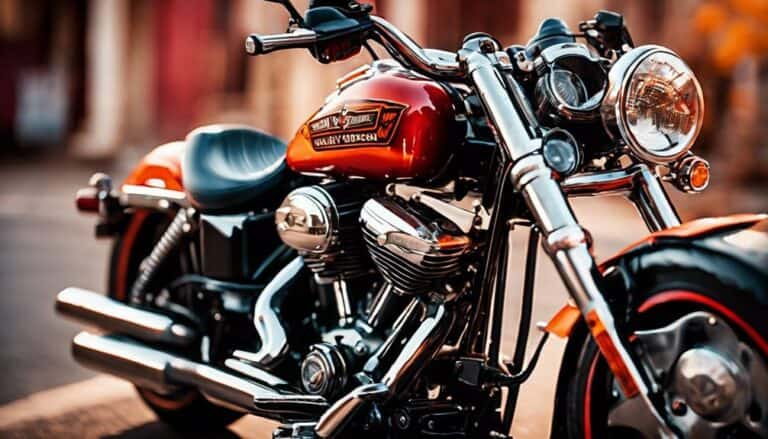Ever heard the saying, 'Loud pipes save lives'?
When it comes to Harley-Davidson motorcycles, the decibel level can be a topic of curiosity.
You might be surprised to learn that the sound produced by a Harley can vary depending on several factors.
Understanding the nuances of Harley Davidson decibels can shed light on a world where noise isn't just about volume but also about identity and community.
So, how many decibels does a Harley really produce, and what implications does it have?
Key Takeaways
- Harley Davidson motorcycles typically range from 70-80 decibels according to U.S. EPA standards.
- Owner modifications can push Harley Davidson noise levels beyond 100 decibels.
- New Harley models adhere to the 80dB limit set by the U.S. EPA Code.
- Ultra-noisy Harleys often result from aftermarket alterations exceeding factory specs.
Sound Levels of Harley Davidson
When assessing the sound levels of Harley Davidson motorcycles, it's crucial to note that the average range falls between 70 and 80 decibels according to U.S. EPA standards. New Harley-Davidson motorcycles adhere to the 80dB limit set by the U.S. EPA Code.
However, some owners opt to modify their bikes, pushing sound levels beyond 100 decibels through aftermarket alterations. It's essential to understand that ultra-noisy Harleys typically result from owner modifications rather than factory production. These aftermarket modifications play a significant role in increasing the sound levels of Harley-Davidson motorcycles.
Riders seeking a more robust auditory experience often turn to these modifications to personalize their bikes and stand out on the road. While factory Harleys maintain a respectable sound level range, the aftermarket offers a realm of possibilities for those looking to amplify the distinctive rumble associated with Harley Davidson motorcycles.
Understanding Harley Davidson Decibels
The sound levels of Harley Davidson motorcycles, particularly in relation to decibels, are crucial to understand for both riders and enthusiasts. Harley-Davidson bikes typically range from 70-80 decibels in sound levels when in their factory condition. However, aftermarket modifications done by owners can significantly increase the sound levels of these motorcycles.
It's important to note that ultra-noisy Harleys, exceeding 100 decibels, are often the result of these owner modifications rather than the factory production. In the past, Harley dealerships have offered modification packages aimed at enhancing the sound levels of their bikes. The iconic 'potato-potato' sound associated with Harley-Davidson motorcycles is a trademark feature attributed to the V-Twin two-cylinder engine design.
Understanding the decibel levels of Harley Davidson motorcycles can provide riders with insights into the impact of modifications on sound output, allowing for informed decisions when customizing their bikes.
Comparing Harley Davidson Noise Levels
In assessing Harley Davidson noise levels, it's essential to consider the impact of aftermarket modifications on sound output. While new Harleys comply with the 80dB limit set by the U.S. EPA Code, Harley-Davidson bikes typically average between 70-80 decibels. However, the introduction of aftermarket modifications by owners can significantly increase sound levels beyond factory specifications.
- Loud pipes may enhance the overall riding experience for some, but they can also disturb the peace of others.
- Aftermarket modifications can push Harley-Davidson noise levels well above the acceptable limits, reaching over 100 decibels in extreme cases.
- Ultra-noisy Harleys are often the result of owner modifications rather than the standard production from the factory.
Regulations on Harley Davidson Decibels
Regulations governing Harley Davidson decibels vary across jurisdictions, with specific limits imposed on sound levels at idle and during operation. For instance, Myrtle Beach law sets an idle limit of 92dB for Harley Davidsons, and exceeding this threshold results in failure. Bylaws commonly restrict Harley Davidsons to 92dB at idle and 96dB at 2000 rpm for twin-cylinder bikes.
New Harley models adhere to the 80dB limit outlined in the U.S. EPA Code, typically maintaining sound levels between 70-80 decibels. However, owners often opt for aftermarket modifications that can push the sound levels beyond factory standards. Consequently, ultra-noisy Harleys frequently stem from these owner-initiated alterations, with some reaching astonishing levels exceeding 100 decibels.
It's essential for Harley riders to be aware of the specific regulations in their area to ensure compliance and avoid potential penalties associated with excessive noise emissions caused by aftermarket modifications.
Impact of Harley Davidson Noise
Enhancing Harley Davidson noise levels through aftermarket modifications can have significant implications on both rider experience and community noise pollution. Despite factory-produced Harley-Davidson motorcycles complying with the 80dB limit set by U.S. EPA Code regulations, some owners opt for ultra-noisy bikes by modifying their exhaust systems. This choice, while popular for the image and appeal it creates, comes with consequences.
- Increased rider satisfaction through a sense of rebellion and freedom.
- Greater community annoyance and potential legal repercussions due to excessive noise levels.
- Long-term hearing damage for both riders and bystanders exposed to prolonged loud motorcycle exhaust sounds.
Considering the balance between personal expression and societal responsibility is crucial when deciding on aftermarket modifications that affect Harley Davidson sound levels. Being mindful of the impact one's choices have on oneself and others can lead to a more harmonious coexistence between riders and the communities they traverse.
Conclusion
So, you've learned that Harley-Davidson motorcycles typically range from 70-80 decibels, but aftermarket modifications can push them over 100 decibels.
The unique sound of a Harley's V-Twin engine sets it apart, like a roaring lion in a jungle of quiet whispers.
Despite noise concerns, many riders embrace the loudness for its bold presence on the road.
Whether you love or loathe the noise, one thing is certain – a Harley's sound can't be ignored.

